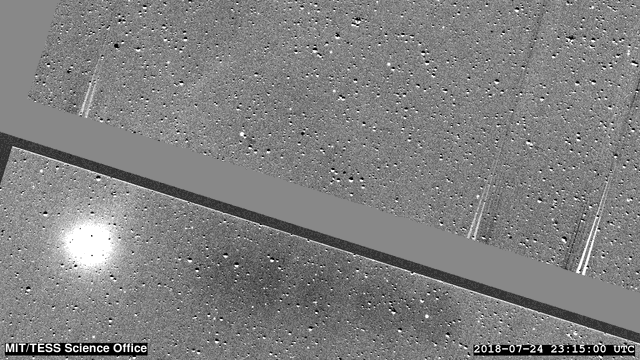by Natalia Guerrero, TESS Science Office
In a series of full-frame images taken over the course of 17 hours, a comet streaked across the bottom corner of one of the CCDs in TESS Camera 1. TESS had been operating in commissioning mode since May and the images in which the comet appears were one of the last data sets collected before the spacecraft began science operations on July 25, 2018. In addition to the comet, variable stars blink on and off and small asteroids drift slowly across the frame.

When the Deep Space Network (DSN) at NASA JPL delivers the images to the TESS Science Office at MIT, the Payload Operations Center (POC) team unpacks the compressed data. The POC team subtracts background from the full-frame images (FFIs) for a cursory first look at the data.
In a series of 30 FFIs, the team identified a small, oblong object moving across a CCD in Camera 1, which is oriented to observe a 24-by-24-degree area of sky close to the ecliptic. András Pál, a TESS collaborator from Konkoly Observatory, used the open-source FITSH software package to combine the images into a movie of the comet.
The images were prepared using a method called “median subtraction.” This takes the median value of each pixel over the whole series and subtracts it from every image. Stars and other objects that are brighter than this median value appear as white or light grey and objects dimmer than the median appear as black or dark grey. The “blinking LED” effect of some of the stars in the field is due to stars varying in brightness above and below the median.
With information about the spacecraft pointing and the timestamp from the images, Pál and the team were able to back out the RA and Dec of the comet. Using the tools provided by the Minor Planet Center and NASA/Horizons, this object was identified without any ambiguity as C/2018 N1, a comet found on June 29 by NASA’s Near-Earth Object Wide-field Infrared Survey Explorer (NEOWISE). Currently, C/2018 N1 is located about 29.8 million miles (48 million kilometers) from Earth in the southern constellation Piscis Austrinus. In this movie, the comet moves left to right, or from east to west in the sky, orbiting the Sun which is always directly opposite the TESS field of view. The comet’s swirling tail of gas and dust swings around like a weather vane following the direction of the solar wind (in the upper CCD of Camera 1) as the comet’s bright nucleus moves across the frame (in the lower CCD of camera 1). The nucleus of the comet has a TESS magnitude of ~10.2 while the total brightness including the coma is around ~9.5.
The comet “movie” also shows dark stripes moving back and forth as the movie progresses, caused by light from Mars, just outside the camera field of view and the closest and brightest it’s been to Earth in decades. Stray light from Mars is also possibly the cause of the faint, broad arc that moves across the frame.
The TESS team wishes C/2018 N1 well on its journey through the solar system and looks forward to more serendipitous discoveries in the first orbit’s data, which arrived at MIT on August 8.
Learn more about TESS at nasa.gov/tess
Download the C/2018 N1 movie here